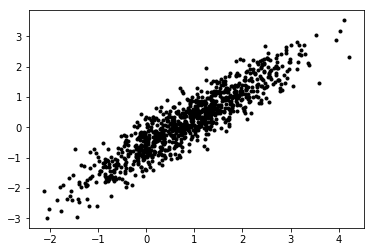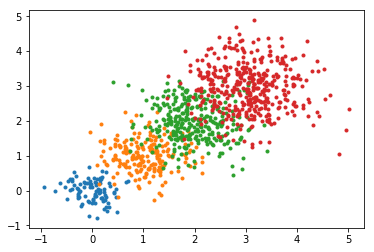Parameter containers.¶
Many models depend on several parameters of different types. In this notebook, we demonstrate flattening and folding “containers”, which are patterns containing other patterns.
Parameter dictionaries.¶
[1]:
import autograd
import autograd.numpy as np
import example_utils
import matplotlib.pyplot as plt
import paragami
import time
%matplotlib inline
Let’s consider a multivariate normal example. Define some parameters and draw some data.
[2]:
dim = 2
num_obs = 1000
mean_true = np.random.random(dim)
cov_true = np.random.random((dim, dim))
cov_true = 0.1 * np.eye(dim) + np.full((dim, dim), 1.0)
x = np.random.multivariate_normal(mean=mean_true, cov=cov_true, size=(num_obs, ))
plt.plot(x[:, 0], x[:, 1], 'k.')
[2]:
[<matplotlib.lines.Line2D at 0x7f6a3bd86dd8>]

A multivariate normal distribution depends on two parameters – a mean and a positive definite covariance matrix. In Python, we might store these parameters in a dictionary with a member for the mean and a member for the covariance.
This can be represented with a pattern dictionary, i.e., a paragami.PatternDict pattern. Each member of a pattern dictionary must itself be a pattern.
[3]:
mvn_pattern = paragami.PatternDict(free_default=True)
mvn_pattern['mean'] = paragami.NumericVectorPattern(length=dim)
mvn_pattern['cov'] = paragami.PSDSymmetricMatrixPattern(size=dim)
Flattening and folding work with pattern dictionaries just as with ordinary patterns. Note that folded pattern dicitonaries are OrderedDict by default.
[36]:
true_mvn_par = dict()
true_mvn_par['mean'] = mean_true
true_mvn_par['cov'] = cov_true
print('\nA dictionary of MVN parameters:\n{}'.format(
true_mvn_par))
mvn_par_free = mvn_pattern.flatten(true_mvn_par)
print('\nA flat representation:\n{}'.format(
mvn_pattern.flatten(true_mvn_par)))
print('\nFolding recovers the original parameters:\n{}'.format(
mvn_pattern.fold(mvn_par_free)))
A dictionary of MVN parameters:
{'cov': array([[1.1, 1. ],
[1. , 1.1]]), 'mean': array([0.87367236, 0.21280422])}
A flat representation:
[ 0.87367236 0.21280422 0.04765509 0.95346259 -0.82797896]
Folding recovers the original parameters:
OrderedDict([('mean', array([0.87367236, 0.21280422])), ('cov', array([[1.1, 1. ],
[1. , 1.1]]))])
Parameter dictionaries are particularly convenient for optimization problems involving multiple parameters. A good working style is to implement the loss function using named arguments and then wrap it using a lambda function.
To illustrate this, let us use get_normal_log_prob from example_utils.
[6]:
# ``example_utils.get_normal_log_prob`` returns the log probability of
# each datapoint x up to a constant.
def get_loss(x, sigma, mu):
return -1 * np.sum(
example_utils.get_normal_log_prob(x, sigma, mu))
get_free_loss = paragami.FlattenFunctionInput(
lambda mvn_par: get_loss(x=x, sigma=mvn_par['cov'], mu=mvn_par['mean']),
patterns=mvn_pattern,
free=True)
print('Free loss:\t{}'.format(get_free_loss(mvn_par_free)))
print('Original loss:\t{}'.format(get_loss(x, true_mvn_par['cov'], true_mvn_par['mean'])))
Free loss: 219.8143711666299
Original loss: 219.8143711666299
As with other parameters, autograd works with parameter dictionaries.
[7]:
get_free_loss_grad = autograd.grad(get_free_loss)
print(get_free_loss_grad(mvn_par_free))
[-59.66882221 78.5304 -24.49767189 -12.36127117 36.00719091]
Pattern dictionaries containing pattern dictionaries.¶
Pattern dictionaries can contain pattern dictionaries (and so on).
[34]:
mvns_pattern = paragami.PatternDict(free_default=True)
mvns_pattern['mvn1'] = mvn_pattern
mvns_pattern['mvn2'] = mvn_pattern
mvns_pattern['ez'] = paragami.SimplexArrayPattern(array_shape=(1, ), simplex_size=2)
mvns_par = dict()
mvns_par['mvn1'] = true_mvn_par
mvns_par['mvn2'] = mvn_pattern.random()
mvns_par['ez'] = np.array([[0.3, 0.7]])
print('Folded mvns_par:\n{}'.format(mvns_par))
print('\nFree mvns_par:\n{}'.format(mvns_pattern.flatten(mvns_par)))
Folded mvns_par:
{'mvn1': {'cov': array([[1.1, 1. ],
[1. , 1.1]]), 'mean': array([0.87367236, 0.21280422])}, 'mvn2': OrderedDict([('mean', array([0.9666736 , 0.24848757])), ('cov', array([[4.77849291, 1.56784344],
[1.56784344, 1.84355085]]))]), 'ez': array([[0.3, 0.7]])}
Free mvns_par:
[ 0.87367236 0.21280422 0.04765509 0.95346259 -0.82797896 0.9666736
0.24848757 0.7820626 0.71722798 0.14226413 0.84729786]
Members of a pattern dictionary are just patterns, and can be used directly.
[37]:
mvn_par_free = mvns_pattern['mvn1'].flatten(true_mvn_par)
print('\nA flat representation of true_mvn_par:\n{}'.format(
mvn_pattern.flatten(true_mvn_par)))
A flat representation of true_mvn_par:
[ 0.87367236 0.21280422 0.04765509 0.95346259 -0.82797896]
Locking parameter dictionaries.¶
The meaning of a parameter dictionary changes as you add or assign elements.
[40]:
example_pattern = paragami.PatternDict(free_default=True)
example_pattern['par1'] = paragami.NumericVectorPattern(length=2)
print('The flat length of example_pattern with par1:\t\t\t{}'.format(
example_pattern.flat_length()))
example_pattern['par2'] = paragami.NumericVectorPattern(length=3)
print('The flat length of example_pattern with par1 and par2:\t\t{}'.format(
example_pattern.flat_length()))
example_pattern['par1'] = paragami.NumericVectorPattern(length=10)
print('The flat length of example_pattern with new par1 and par2:\t{}'.format(
example_pattern.flat_length()))
The flat length of example_pattern with par1: 2
The flat length of example_pattern with par1 and par2: 5
The flat length of example_pattern with new par1 and par2: 13
Sometime, you want to make sure the meaning of a parameter dictionary stays fixed. In order to prevent a pattern dictionary from having more elements added, you can lock() it.
[43]:
example_pattern.lock()
try:
example_pattern['par3'] = paragami.NumericVectorPattern(length=4)
except ValueError as err:
print('Adding a new pattern failed with the following error:\n{}'.format(err))
try:
example_pattern['par1'] = paragami.NumericVectorPattern(length=4)
except ValueError as err:
print('\nChanging an existing pattern failed with the following error:\n{}'.format(err))
Adding a new pattern failed with the following error:
The dictionary is locked, and its values cannot be changed.
Changing an existing pattern failed with the following error:
The dictionary is locked, and its values cannot be changed.
Parameter arrays.¶
Sometimes it is useful to have arrays of patterns. A classic use case is mixture distributions. Suppose that, for some \(K\), and probabilities \(\pi_{k}\) for \(k=1\) to \(K\),
Then the random variable \(y_n\) is distributed according to a mixture of normals. Let us define parameters and draw some data.
[64]:
num_components = 4
prob_true = np.arange(1, num_components + 1)
prob_true = prob_true / np.sum(prob_true)
k_true = np.random.choice(range(num_components), p=prob_true, size=num_obs)
means_true = np.array([
np.full(dim, float(k)) for k in range(num_components) ])
covs_true = np.array([
0.1 * (k + 1) * np.eye(dim) for k in range(num_components) ])
y = np.array([
np.random.multivariate_normal(
means_true[k_true[n], :],
covs_true[k_true[n], :, :]) for n in range(num_obs) ])
for k in range(num_components):
k_rows = k_true == k
plt.plot(y[k_rows, 0], y[k_rows, 1], '.')

To define parameters for the mixture, we have defined arrays of shape (num_components, ) containing the means and covariances. The means can be represented with an orderinary NumericArrayPattern. But to represent the array of covariances with paragami, we can use pattern arrays, i.e, paragami.PatternArray.
[79]:
mix_pattern = paragami.PatternDict(free_default=True)
mix_pattern['prob'] = paragami.SimplexArrayPattern(
array_shape=(1, ), simplex_size=num_components)
mix_pattern['means'] = paragami.NumericArrayPattern(shape=(num_components, dim))
mix_pattern['covs'] = paragami.PatternArray(
array_shape=(num_components, ),
base_pattern=paragami.PSDSymmetricMatrixPattern(size=dim))
true_mix_par = dict()
true_mix_par['means'] = means_true
true_mix_par['covs'] = covs_true
true_mix_par['prob'] = np.expand_dims(prob_true, axis=0)
true_mix_free = mix_pattern.flatten(true_mix_par)
print('Folding recovers the true mixture parameters:\n{}'.format(
mix_pattern.fold(true_mix_free)))
Folding recovers the true mixture parameters:
OrderedDict([('prob', array([[0.1, 0.2, 0.3, 0.4]])), ('means', array([[0., 0.],
[1., 1.],
[2., 2.],
[3., 3.]])), ('covs', array([[[0.1, 0. ],
[0. , 0.1]],
[[0.2, 0. ],
[0. , 0.2]],
[[0.3, 0. ],
[0. , 0.3]],
[[0.4, 0. ],
[0. , 0.4]]]))])
Pattern arrays have some limitations. For one, they can only contain numeric types. This means you cannot have arrays of pattern dictionaries.
[76]:
example_pattern = paragami.PatternDict()
example_pattern['a'] = paragami.NumericVectorPattern(length=2)
try:
paragami.PatternArray(array_shape=(2, ), base_pattern=example_pattern)
except NotImplementedError as err:
print('Attempting to create a PatternArray of PatternDicts failed with the error:\n{}'.format(
err))
Attempting to create a PatternArray of PatternDicts failed with the error:
PatternArray does not support patterns whose folded values are not numpy.ndarray types.
Also, under the hood, PatternArray types fold and flatten using a for loop over the array elements. For this reason, it is more effecient to use a different type if possible.
In particular, SimplexArray patterns will be more efficient than a PatternArray of SimplexArray, as the following example shows.
[108]:
import time
array_shape = (50, 10)
test_array = paragami.PatternArray(
array_shape=array_shape,
base_pattern=paragami.SimplexArrayPattern(array_shape=(1, ), simplex_size=5))
test_simplex = paragami.SimplexArrayPattern(array_shape=array_shape, simplex_size=5)
simplex_val = test_simplex.random()
simplex_array_val = np.expand_dims(simplex_val, axis=2)
test_times = 10
simplex_time = time.time()
for i in range(test_times):
test_simplex.flatten(simplex_val, free=True)
simplex_time = time.time() - simplex_time
array_time = time.time()
for i in range(test_times):
test_array.flatten(simplex_array_val, free=True)
array_time = time.time() - array_time
print('Array time:\t{}\nSimplex time:\t{}'.format(array_time, simplex_time))
Array time: 0.30515265464782715
Simplex time: 0.0015544891357421875